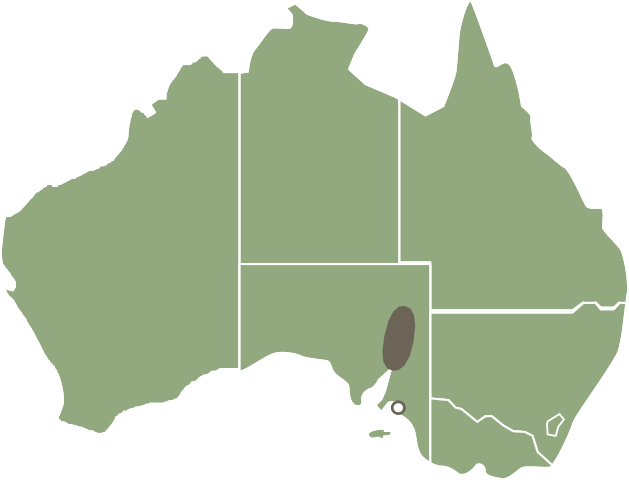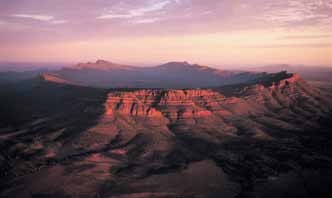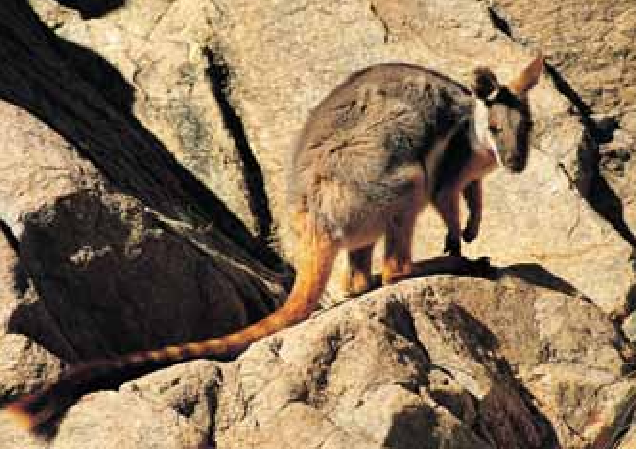The Flinders Ranges
弗林德斯山脉

A journey through Flinders Ranges is a voyage of peaceful discovery. These ancient ranges are renowned for their spectacular geology — their rugged mountains, deep gorges and sheltered creeks. They are home to abundant wildlife and a rich cultural tradition. Their weathered canyons whisper of a time forgotten, a story begun 800 million years ago when life began.
REVEALING THE STORY OF LIFE ON EARTH
Once an ancient inland sea, powerful forces in the earth caused massive upheavals, creating giant mountain ranges. Today’s landscape is the result of these ranges eroding over hundreds of millions of years.
The Flinders Ranges contain one ofthe most intact and rich Ediacara fossil sites in the world. The fossils provide the earliest known evidence of multicellular animal life — over 540 million years ago. So important are these fossils that the Ediacara period has been named afterthem.
Ancient lands, new discoveries
A recent discovery of primitive sponge fossils in the Flinders Ranges suggest animals may have been on Earth for at least 650 million years — 70 million years earlier than previously thought.
ANCIENT CONNECTIONS
The Ad nya mat han ha are the Indigenous people ofthe Flinders Ranges. The name, meaning rocks or hills, describes the five traditional groups who live in the ranges. Their connection with the land remains strong to this day and enmeshed in the landscape are songlines, rock art and sacred sites.
The Ad nya mat han ha tell the story of how Wilpena Pound was formed by two giant Akurra serpents which circled and ate a group of people attending a ceremony. Occasional earth tremors are said to be the rumblings ofthe Akurra’s belly after their feast.
WHAT ARE SONGLINES?
Also called dreamingtracks, songlines are paths acrossthe land which markthe route followed by ‘creator beings’. The paths ofthe songlines are recorded in traditional songs, stories, dance, and paintings. Indigenous people use them to navigate across the land by repeating the words of a song which describe locations, waterholes and other natural features.
Although songlines may cross several different language groups, it is said that the landscape is encapsulated in its rhythm and melody and can be understood by those who know howto interpret them.
Nantawarrina conservation work brings global awards The first declared Indigenous Protected Area in Australia, Nantawarrina spreads across 58,000 hectares of rugged terrain between the Flinders Ranges and Gammon Ranges National Parks.
The Adnyamathanha people have revitalised their community, created a sense of purpose and renewed cultural connections through activities such as growing bushfoods, running cultural tours, land rehabilitation and providing facilities for sustainable tourism.
In 2000, these achievements were recognised through a United Nations Environment Program award, and Nantawarrina joined the Global 500 Roll of Honour for Environmental Achievement. The success of Nantawarrina inspired the creation of Indigenous Protected Areas, with 43 sites now declared across Australia.
A LIVING LANDSCAPE
Wildlife abounds in the landscape, from red kangaroos and flightless emus to the brilliant flashing wings of parrots, lorikeets and rosellas and magnificent wedge-tailed eagles soaringthrough vast blue skies.
The ranges are hometo morethan half of South Australia’s 3,100 plant species. Ancient river red gums dominate the dry creek beds, ferns shelter amongst moist shaded spots along the rocky slopes protected from the wind and the sun, and remnant orchid pockets can be found throughout the area.
Yellow-footed rock-wallaby
The striking ochre, grey, black, brown and white markings of the 65 centimetre high yellow-footed rock-wallaby are synonymous with the Flinders Ranges where they inhabit cliff lines that provide vegetation, moisture and shelter from the harsh Australian sun.
In the past, hunting for their fur, competition with sheep and cattle and predation by invasive species such as cats and foxes sawtheir numbers decline.Today habitat protection and control of predators are seeing numbers slowly start to recover.
FLINDERS - PART OF A BROADER CONSERVATION EFFORT
The Flinders Ranges, with its extensive network of public, private and Indigenous parks and reserves, form part of NatureLinks, a South Australian program that manages and restores large areas of habitat across the state. By providing vital links so animals and plants can move large distances, the program helps reduce local extinctions and improves species stability.
弗林德斯山脉
弗林德斯山脉之旅会是一次平和悠闲的发现之旅。这些古老的山脉以其壮观的地质景观闻名于世,那里有着崎岖的山脉、深邃的峡谷和淙淙的溪流。此地拥有多样的野生动植物和丰富的文化传统,风化的峡谷仿佛在低语着古老的传说,细说着8亿年前生命开始时的景象。
地球生命故事的呈现者
这里曾经是一个古老的内陆海域,地壳运动的强大力量导致地表明显隆起,形成了巨大的山脉。今天的景观就是山脉侵蚀数亿年的结果。 弗林德斯山脉是世界上拥有最完整,最丰富的埃迪卡拉生物群化石的地点之一。这些化石证明了最早的已知多细胞生命已有5.4亿多年。这些化石的发现非常重要,埃迪卡拉纪命名由此而来。 古老的土地,崭新的发现 弗林德斯山脉最近发现的原始海绵化石表明,动物物种可能已经在地球上存在了至少6.5亿年,这比之前想象的早了7000万年。
古老的纽带
阿亚曼塔哈人是弗林德斯山脉的土著人。这个名字的意思是“岩石”或“山丘”,也代表了生活在这片山脉中的五个传统土著人群体。
他们与这片土地一直保持着紧密的联系,在风景之中融入了自己的文化,编排了版图史歌,刻画了岩石艺术,建造了圣地。 阿亚曼塔哈人中流传着这样的故事:巨大的环形谷地——维凭拿庞由两只巨大的阿库拉巨蟒盘旋而成,巨蟒还吞噬了一群参加仪式的人,据说偶尔的地震波动就是由它们饱餐一顿之后,腹部蠕动引起的。
南塔瓦里纳保护区工作获得全球奖项
南塔瓦里纳是澳大利亚首次申报的土著保护区,横跨弗林德斯山脉和金门山脉国家公园之间58,000公顷的崎岖地带。 阿亚曼塔哈人通过种植灌木,开展文化旅游,修复土地和开展可持续旅游等活动,重建了自己的社区,加强了文化传播。 2000年,这些成就得到了联合国环境规划署的认可,南塔瓦里纳荣登全球环境成就500强荣誉榜。 南塔瓦里纳的成功促进了土著保护区的建立,目前在澳大利亚各地已经建立了43个保护区。
生机勃勃的景点
这里的野生动物种类繁多,有红袋鼠、鸸鹋、翅膀绚丽的大鹦鹉、彩虹鹦鹉和大头鹦鹉,还有翱翔蓝天的楔尾雕。 南澳大利亚约有3,100种植物,这个山脉为其中一半以上提供了扎根之地。古老的赤桉在干涸的河床上肆意生长,蕨类植物生长在岩石山坡上的潮湿阴影处,可防风防晒,到处都可以看到兜兰花花瓣的身影。
黄足岩小袋鼠
黄足岩小袋鼠身高65厘米,其毛色为赭色、灰色、黑色、棕色和白色混杂,是弗林德斯山脉的代表。它们栖息在有植被且潮湿的悬崖峭壁上,可以抵挡太阳的暴晒。 在过去,常有猎人捕猎它们的皮毛,它们也要与牛羊竞争食物,还要面对入侵物种,如猫和狐狸的捕食,所以数量急剧下降。今天,随着栖息地保护活动的开展和对捕食者的控制,黄足岩小袋鼠的数量正在逐步恢复。



